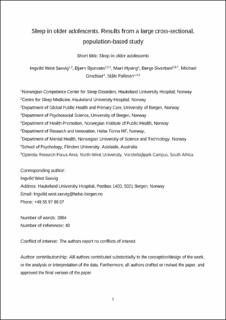Sleep in older adolescents. Results from a large cross-sectional, population-based study
Saxvig, Ingvild W.; Bjorvatn, Bjørn; Hysing, Mari; Sivertsen, Børge; Gradisar, Michael; Pallesen, Ståle
Journal article, Peer reviewed
Accepted version
Permanent lenke
https://hdl.handle.net/11250/2762765Utgivelsesdato
2021Metadata
Vis full innførselSamlinger
Sammendrag
The aim of the present study was to describe sleep patterns in a large and representative sample of Norwegian adolescents. The sample included 4,010 first-year high school students, aged 16–17 years (54% female), who completed a web-based survey on sleep patterns. The process of going to sleep was addressed as a two-step sequence of (a) shuteye latency (interval from bedtime to shuteye time) and (b) sleep onset latency (interval from shuteye time to sleep onset). Results showed that 84.8% of the adolescents failed to obtain the recommended amount of sleep (8+ h) on schooldays, and 49.4% obtained less than 7 h. Mean bedtime on schooldays was 10:33 PM, with rise time 8:19 h later (time in bed). The adolescents reported long school-day shuteye latency (43 min), limiting sleep opportunity to 7:36 h. Sleep onset latency was 32 min and mean school-day sleep duration was only 6:43 h. On free days, 26.3% of the adolescents obtained less than 8 h of sleep, and 11.7% obtained less than 7 h. Mean bedtime was 00:33 AM, time in bed was 10:35 h, shuteye latency was 39 min and sleep onset latency was 24 min. Mean free-day sleep duration was 8:38 h. There were sex differences in several sleep parameters, including shuteye latency. The results indicate that the majority of Norwegian adolescents fail to obtain the recommended amount of sleep (8+ h) on schooldays. Long shuteye latency appears to be a main driver for short school-day sleep duration in adolescents.
